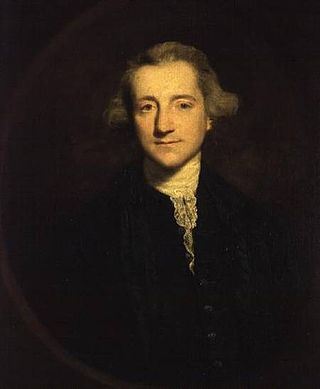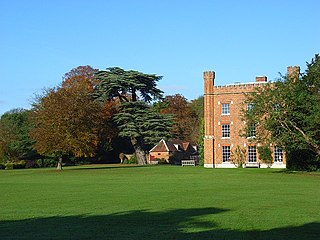
Samuel Whitbread was an English brewer and Member of Parliament. In 1742, he established a brewery that in 1799 became Whitbread & Co Ltd.

White Waltham is a village and civil parish, 3.5 miles (6 km) west of Maidenhead, in the Royal Borough of Windsor and Maidenhead in Berkshire, England. It is crossed briefly by the M4 motorway, which along with the Great Western Main Line and all other roads covers 0.267 square kilometres (0.103 sq mi) of the parish and 'greenspace' which includes cultivated fields covers the most part - this covered 9.421 square kilometres (3.637 sq mi). White Waltham Airfield is in the parish.

Henry Vansittart was an English colonial administrator, who was the Governor of Bengal from 1759 to 1764.

Shottesbrooke is a hamlet and civil parish administered by the unitary authority of the Royal Borough of Windsor and Maidenhead in the English county of Berkshire. The hamlet is mostly rural: 88% covered by agriculture or woodland and had a population of 141 at the 2011 census.
The High Sheriff of Tipperary was the Sovereign's judicial representative in County Tipperary. Initially an office for a lifetime, assigned by the Sovereign, the High Sheriff became annually appointed from the Provisions of Oxford in 1258. Besides his judicial importance, he had ceremonial and administrative functions and executed High Court Writs.
The High Sheriff of Monaghan was the British monarch's representative in County Monaghan, a territory known as his bailiwick. Selected from three nominated people, he held his office for the duration of a year. He had judicial, ceremonial and administrative functions and executed High Court Writs.

Colonel Sir John Burke, 2nd Baronet, DL was an Irish soldier and Whig politician who was MP for Galway County (1830–2) and High Sheriff of County Galway (1838–9).

Admiral Sir Sydney Colpoys Dacres was an officer of the Royal Navy who saw service during the Greek War of Independence, when he was involved in an attack on the Turkish forces at Morea, and later during the Crimean War. Born into a substantial naval dynasty during the Napoleonic Wars, he eventually rose to the rank of Admiral and became First Naval Lord. His only significant action as First Naval Lord was to press for the abolition of masts. He went on to be Visitor and Governor of Greenwich Hospital.
This is a list of sheriffs and high sheriffs of Shropshire

The baronetcy of Conyers of Horden was created in the Baronetage of England on 14 July 1628 for John Conyers of Horden, County Durham.
The High Sheriff of Oxfordshire, in common with other counties, was originally the King's representative on taxation upholding the law in Saxon times. The word Sheriff evolved from 'shire-reeve'.
Charles Douglas, 6th Marquess of Queensberry,, known as Sir Charles Douglas, 5th Baronet between 1783 and 1810, was a Scottish peer and member of Clan Douglas.

Sir Richard Powle of Shottesbrooke Park, Berkshire was an English lawyer and politician who sat in the House of Commons from 1660 to 1678.
The High Sheriff of Mayo was the British Crown's judicial representative in County Mayo, Ireland from the 16th century until 1922, when the office was abolished in the new Free State and replaced by the office of Mayo County Sheriff. The sheriff had judicial, electoral, ceremonial and administrative functions and executed High Court Writs. In 1908, an Order in Council made the Lord-Lieutenant the Sovereign's prime representative in a county and reduced the High Sheriff's precedence. However, the sheriff retained his responsibilities for the preservation of law and order in the county. The usual procedure for appointing the sheriff from 1660 onwards was that three persons were nominated at the beginning of each year from the county and the Lord Lieutenant then appointed his choice as High Sheriff for the remainder of the year. Often the other nominees were appointed as under-sheriffs. Sometimes a sheriff did not fulfil his entire term through death or other event and another sheriff was then appointed for the remainder of the year. The dates given hereunder are the dates of appointment. All addresses are in County Mayo unless stated otherwise.
Admiral Sir George Digby Morant was an Anglo-Irish admiral in the British Royal Navy.

Wadham Locke (1779–1835) was an English banker and politician.

Sir John Stonhouse, 3rd Baronet, PC (c.1672–1733) was an English landowner and Tory politician who sat in the English and then British House of Commons from 1701 to 1733.

General George Alexander Malcolm, CB, was a British Army officer. He served in the First Anglo-Chinese War and became the first Colonial Secretary of Hong Kong in 1843.

Sir Richard Digby Neave, 3rd Baronet (1793–1868), usually known as Digby Neave, was an English artist and author.
Hon. Philip Bouverie-Pusey was an English heir and landowner.













